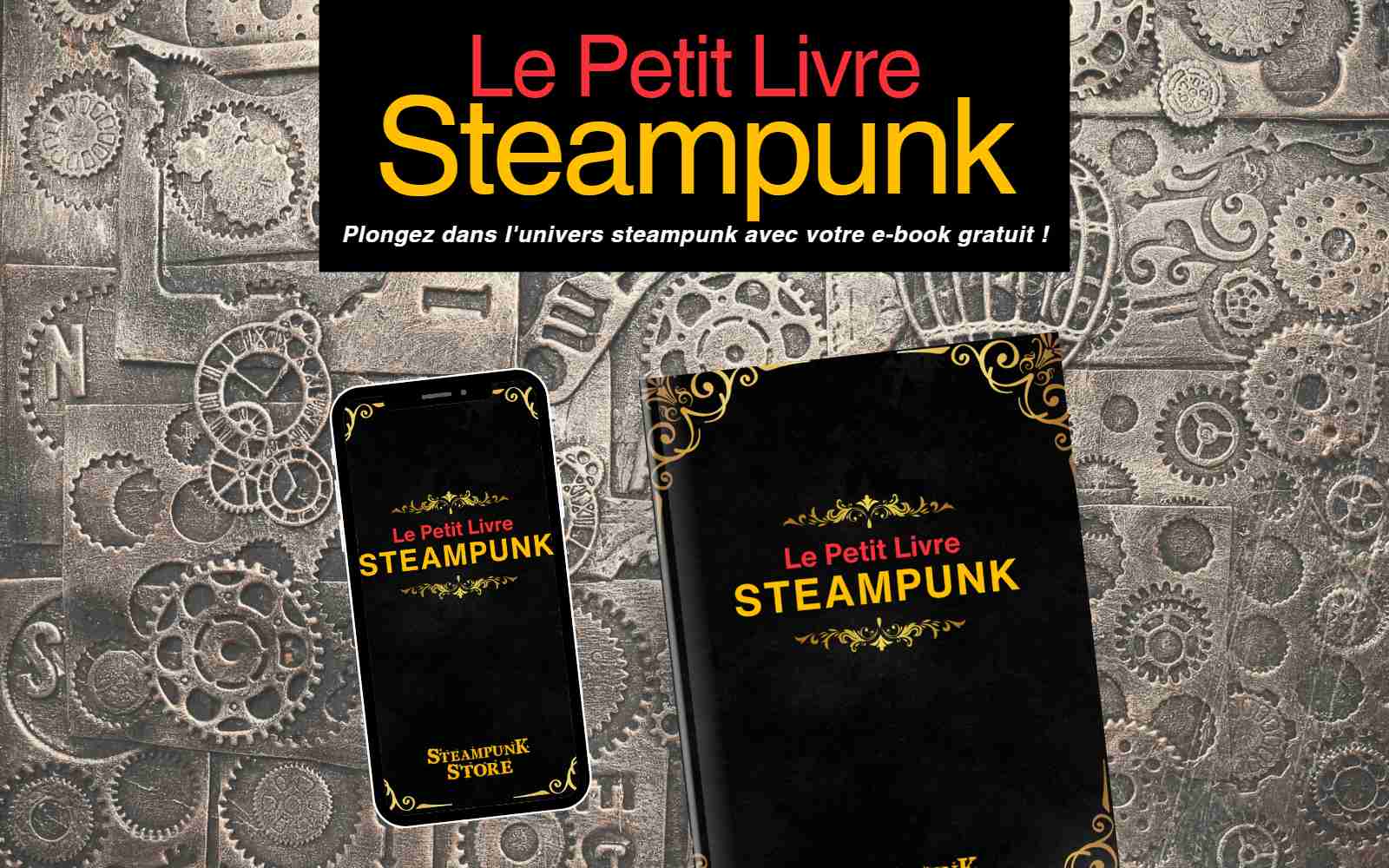The Steampunk universe and Victorian England are so linked that it is sometimes difficult to tell the difference. With Christmas approaching, we wanted to share with you 9 amazing things about this period that has shaped so many things present in our end-of-year celebrations.
1- The Victorian Christmas tradition was built during the Industrial Revolution in the United Kingdom, under the reign of Queen Victoria, marking a significant period in British history.
It is hard to imagine today, but in the early 19th century, Christmas was barely celebrated in Britain. Many businesses, especially in the railway and Victorian invention industries, did not even consider it a public holiday. However, by the end of that era, marked by the rise of the middle class and the emergence of the labour movement, Christmas had become the nation's largest annual celebration. It took on the cultural form we know today, thanks in part to figures like Charles Dickens. The transformation came quickly and came from all sectors of Victorian society, including the architecture and fashion of the time.
2- The Influence of Queen Victoria on Victorian Christmas in the United Kingdom.

Queen Victoria, an iconic figure of the United Kingdom and the British Empire, played a pivotal role in transforming Christmas celebrations. Her reign, which coincided with the Industrial Revolution, saw the emergence of many traditions and inventions that have become cornerstones of the holiday. Indeed, it was under her influence and that of her husband, Prince Albert, that the Christmas tree became a central part of the festivities. Their family, representing the rising middle class, helped popularize the tradition in Britain and beyond. The Victorian style, with its blend of elegance and grandeur, also influenced the architecture and fashion of the time, elements that are reflected in Christmas decorations and costumes. Thus, Queen Victoria not only reigned over an empire, but also over the heart of Christmas traditions that continue to this day.
Soon every home in Britain had a tree decorated with candles, sweets, fruit, homemade decorations and small gifts .
Alexandrine Victoire de Kent: The Origin of an Era
Alexandrine Victoria of Kent, better known as Queen Victoria, was an iconic figure in the United Kingdom and the British Empire. Born in 1819, she ascended to the throne during a time of prosperity and the Industrial Revolution. Her reign not only left its mark on British history and culture, but also had a significant impact on Victorian society and the middle class. She is often associated with major advances, such as the railway and various inventions that shaped Britain. Her influence extended far beyond the borders of England, affecting the whole of the United Kingdom and even the British Empire.
3- Literature, vector of the Christmas spirit.
Although Charles Dickens did not invent the Victorian Christmas, his book A Christmas Carol is credited with helping to popularize and spread the Christmas tradition. His novels are full of misery and injustice. Social issues are a central theme. His message to his readers is an expression of morality based on themes of family, charity, goodwill, peace, and happiness. His values encapsulate the spirit of the Victorian Christmas, and are an integral part of the Christmas we celebrate today, even as the commercial aspect increasingly distorts the holiday season.
Many Christmas tales and stories were modernized and made popular during this period, making the Victorian era the birthplace and standard of the Christmas season. It was not until much later that America would influence this holiday with the arrival of the Santa Claus we know, in the colors of Coca Cola...
4- The invention of Christmas postcards.

In 1843, Henry Cole commissioned an artist to design a card for Christmas. The illustration showed a group of people around a table and a Christmas message. Previously used on Valentine's Day, the Victorians extended the custom to Christmas. While valentines were primarily reserved for the young and in love, Christmas cards were sent to everyone, everywhere. During the Gilded Age, they became increasingly sophisticated.
At one shilling each, these cards were expensive for ordinary English people and were therefore not immediately affordable. However, sentiment spread and many children - including Queen Victoria's - were encouraged to make their own Christmas cards. In the age of industrialisation, colour printing technology developed rapidly and the cost of card production fell significantly.
With the introduction of the halfpenny postage rate, the Christmas card industry took off. By the 1880s, card-sending had become extremely popular, creating a lucrative industry that produced 11.5 million cards in 1880 alone. Many households had albums to keep their favourite greeting postcards, helping to preserve them for future generations. The commercialisation of Christmas was well underway.
5- Christmas carols, Merry Christmas!

The Victorian era also revived the age-old custom of caroling to celebrate the season, including giving new life to the 400-year-old song "The First Noel." Not only did they go door-to-door singing for their friends and neighbors, but they also enjoyed caroling in barbershops, tea rooms, homes, or at beautiful candlelit celebrations in local chapels. Where there were carols, there were beautifully illustrated sheet music with Christmas themes up until the early 1900s. Not only are they beautiful, they are highly sought after by collectors today.
6- Generalization of Christmas Decorations and Lights.

Decorating the home at Christmas also became a more elaborate affair. The medieval tradition of using evergreens continued, but the style and placement of these decorations became more important. The old custom of simply decorating walls and windows with branches and twigs became outmoded. Uniformity, order, and elegance were encouraged. There were instructions on how to make elaborate synthetic decorations for those living in cities. In 1881, Cassell's Family Magazine gave strict guidelines to the housewife: "To create a general sense of pleasure, much depends on the surroundings... It is worth while to take a little trouble in decoration."
7- Victorian Christmas gifts.

Traditionally, gifts were given at New Year's, but this shifted as Christmas became more important to the Victorians. At first, gifts were quite modest - fruit, nuts, sweets and small handmade trinkets. These were usually hung on the Christmas tree. However, as gift-giving became more central to the festival, and gifts became larger and shop-bought, they moved under the tree.
8-Prepare a feast for the holidays.
The Christmas feast has its roots before the Middle Ages, but it was during the Victorian era that the dinner we now associate with Christmas began to take shape. Examination of early Victorian recipes shows that mince pies were originally made with meat, a tradition that dates back to Tudor times. However, during the 19th century, the composition of this festive dish underwent a revolution. Meatless mixtures began to gain popularity among some of the upper echelons of society and evolved into the mince pies we know today.

Roast turkey also has its beginnings in Victorian Britain. Previously, other forms of roast meat such as beef and goose were central to the Christmas meal. Turkey was added to this by the wealthier sections of the community in the 19th century, but its perfect size for a middle-class family gathering meant that it became the dominant dish by the early 20th century.
Since carp was a German specialty at the time, Victorian families often served carp on special china dishes decorated with images of the fish during Christmas feasts as well. Many homes also prepared stew, ham, pickles, several types of potatoes as well as oyster dressing, jams, jellies and of course the ever-present pudding. Not so different from some of the items we enjoy during the holiday season today.
9- The invention of Christmas sweets in London.
Another commercial Christmas invention created during the Victorian Empire in 1848 was the widespread and mass-produced confectionery. Tom Smith invented a bold new way to sell sweets. Inspired by a trip to Paris where he saw bonbons (sweet almonds wrapped in paper twists) he came up with the idea of the Christmas cracker. A simple packet filled with sweets that broke when pulled apart. Sweets were replaced by small gifts and paper hats in the late Victorian era. They remained in this form for a very long time as an essential part of a traditional Christmas.

The Victorian era transformed the idea of Christmas so that it became centered around the family. The preparation, the festive meal, the decorations, the gifts, the entertainment and the board games were all essential to the celebration and were to be shared by the whole family.
Here is vaporist, Steampunk also feeds on this Christmas that we could call vintage by insisting on the fantastic and exuberant side. We will write an article soon on the Steam punk Christmas, but the basics are there.
See you soon for a new article on the exciting world of Steampunk.









